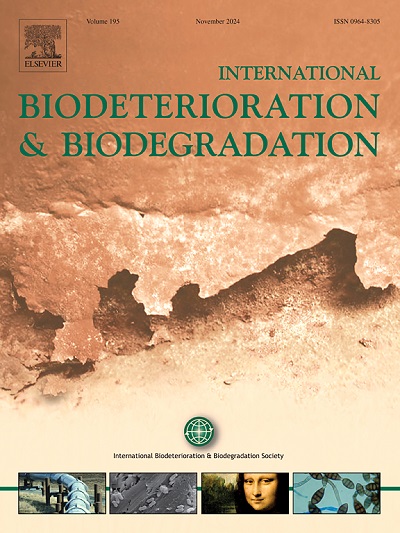Targeted construction of artificial multicellular SND microbial communities and high ammonia-nitrogen wastewater treatment efficiency analysis
IF 4.1
2区 环境科学与生态学
Q2 BIOTECHNOLOGY & APPLIED MICROBIOLOGY
International Biodeterioration & Biodegradation
Pub Date : 2025-06-12
DOI:10.1016/j.ibiod.2025.106153
引用次数: 0
Abstract
Simultaneous nitrification-denitrification (SND) offers a cost-effective approach to nitrogen removal, yet its efficiency is often limited by the instability of natural microbial consortia under fluctuating conditions. This study constructed three artificial multicellular SND microbial communities (consortium A, consortium B, consortium C) by continuously enriching and acclimating using samples from different process sections as the carrier. It elucidated their nitrogen removal mechanisms and engineering application potential. Results demonstrated that consortium B achieved NH4+-N and total nitrogen (TN) removal efficiencies of 95.46 % and 75.84 % within 48 h in a mixed nitrogen source (NH4+-N 350 mg/L, NO3−-N 120 mg/L), with its TN removal rate being 1.10 and 1.16 times higher than those of consortium A and consortium C, respectively. Nitrogen balance and enzyme activity analyses revealed that consortium B exhibited specific activities of 0.6874 U/mg for the key enzyme ammonia monooxygenase (AMO) and 0.4530 U/mg for membrane-bound nitrate reductase (NAR), which were significantly higher than other bacterial flora. The metagenomic analysis revealed that the stable consortium centered on Acinetobacter (62.97 %) was systematically recombined. Among the up-regulated nitrogen metabolism genes, ammonia assimilation, nitrification, and denitrification accounted for 36.85 %, 22.27 %, and 25.03 %, respectively. The nitrogen removal efficiency of consortium B on high-nitrogen wastewater (TN 924.77 mg/L) was 74 % higher than that of the control group in a laboratory-scale bioreactor. This study provides theoretical support and a technological paradigm for optimizing wastewater nitrogen removal using engineered microbial communities.
人工多细胞SND微生物群落的定向构建及高氨氮废水处理效率分析
同时硝化-反硝化(SND)是一种经济有效的脱氮方法,但其效率往往受到自然微生物群落在波动条件下的不稳定性的限制。本研究以不同工艺段的样品为载体,通过不断富集和驯化,构建了3个人工SND多细胞微生物群落(财团A、财团B、财团C)。阐述了它们的脱氮机理和工程应用潜力。结果表明,在混合氮源(NH4+-N 350 mg/L, NO3−-N 120 mg/L)条件下,财团B在48 h内对NH4+-N和总氮(TN)的去除率分别为95.46%和75.84%,其TN去除率分别是财团a和财团C的1.10倍和1.16倍。氮平衡和酶活性分析表明,联合菌群B对关键酶氨单加氧酶(AMO)和膜结合硝酸还原酶(NAR)的比活性分别为0.6874 U/mg和0.4530 U/mg,显著高于其他菌群。宏基因组分析显示,以不动杆菌为中心的稳定联合体(62.97%)被系统重组。在氮代谢上调基因中,氨同化基因、硝化基因和反硝化基因分别占36.85%、22.27%和25.03%。在实验室规模的生物反应器中,财团B对高氮废水(TN 924.77 mg/L)的脱氮效率比对照组高74%。该研究为利用工程微生物群落优化废水脱氮提供了理论支持和技术范例。
本文章由计算机程序翻译,如有差异,请以英文原文为准。
求助全文
约1分钟内获得全文
求助全文
来源期刊
CiteScore
9.60
自引率
10.40%
发文量
107
审稿时长
21 days
期刊介绍:
International Biodeterioration and Biodegradation publishes original research papers and reviews on the biological causes of deterioration or degradation.

 求助内容:
求助内容: 应助结果提醒方式:
应助结果提醒方式:


